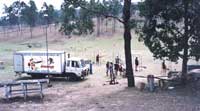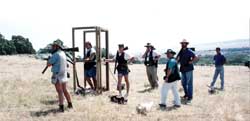Competitive shotgun shooting sports - a brief history
by Ian Campbell
Australian Shooter February 2002
The shotgun has been used to put food on the table for several centuries, but according to written records that have so far been discovered, organised competitive shotgunning has only been with us a little more than 200 years. In February of 1793, in an old English publication, The Sporting Magazine, an article appeared from which you could conclude that competitive shotgunning was well established and was well-known all throughout England. The shoot described in the magazine was at the ‘Old Hats’ on Uxbridge Road near Earling, just out of London. Bucks, Berks, Hants and Surrey were other counties that also had fashionable shooting clubs at this time. These clubs were attended by the upper class and, according to the article, the Old Hats had the best shots. The article also mentioned that there were a large number of spectators attending to witness the shooting and partake in the very best claret and Madeira wine.
 I have always believed that this sport evolved for the need of shooter
equality. Out in the field it is not possible for every shooter to save
the best position or maybe all the game is on the other end of the line,
so having a wager was more like going in a raffle.
I have always believed that this sport evolved for the need of shooter
equality. Out in the field it is not possible for every shooter to save
the best position or maybe all the game is on the other end of the line,
so having a wager was more like going in a raffle.
With trapped live bird shooting, the competition is made more even. The article described some of the rules, conditions, the ground and how the pigeons were released. They used five boxes, 12" long (300mm), 8" wide (200mm) and 10" (250mm) high. These boxes were sunk into the ground five yards apart, parallel to and 21 yards from the footmark, from where each gunner in turn would fire. Each box had a sliding lid, which was level with the top of the ground. A designated puller controlled a cord. The shooter on the mark spun a spinning disk divided and numbered up to five. Only the puller, referee and spectators could see what number the disk stopped at. The shooter, when he was ready, would give the command to have the box lid released. The gunner was not permitted to put the gun to his shoulder until the pigeon was on the wing and it had to fall within 100 yards of the box or it was deemed a lost shot.
The fowling pieces the shooters used in these early club competitions were single barrel flintlocks. Hornsey Wood House in England is believed to be the first pigeon club. In 1880 the first set of shooting rules were drawn up to standardise the sport in England. This appears to be shortly after the introduction of the double barrel fowling piece, which was soon accepted universally. From England, competitive pigeon shooting quickly spread to France, Germany, Italy and Spain. The earliest records of this type of shooting in the USA is in the Sportsman’s Club of Cincinnati, Ohio beginning in 1831, followed in 1840 by The Long Island, New York Gun Club. The next year the New York Sportsman’s Club included live pigeon shooting to its activities.
In George Bigg’s most informative book (History and Records 1936-1992) about the Australian Clay Target Association, he provides evidence of live pigeon gun clubs in Tasmania, Victoria and New South Wales, shooting as early as 1867. However, as a South Australian, I must mention that the Mount Gambier Gun Club (it is the oldest continuously running gun club in Australia, if not the world, as it did not recess during WWII) was founded in August 1872. Since 1954, when live pigeon shooting was abolished in SA, they have shot only clay targets. Victoria was the last state in Australia to cease live pigeon shooting and that was in 1956.
Live pigeon shooting did have an impact on our modern day clay target shooting sports; it provided the first rules for competitor equality. Championships were conducted at the same yardage mark; handicap shooting introduced a system where less proficient shooters stood closer to the traps than expert shots, thus giving them a better opportunity to shoot their target.
We all know about our great modern-day expert Australian trap shooters, Michael Diamond and Russell Mark. But we must also acknowledge that we have excellent women trap shooters like last year’s World Junior Women’s Trap Champion, Angelic Psarakis; World Champion Junior Women’s Double Trap, Susan Trindall and of course the evergreen Deserie Baynes, who, in my opinion, is Australia’s greatest woman trap shooter.
I bet not many shooters would know that a Victorian, Donald Mackintosh, won the gold medals at the Olympics in Paris in 1900 for Game and Live Bird Shooting. His name has been perpetuated in the form of a trophy awarded to the winner of the International Trap Teams Match and it is called The Mackintosh Perpetual International Trophy. The Australian Mackintosh team is selected at each year’s ACTA National Championship. The highest 25 individual scores from the National Double Barrel, Single Barrel and Point Score Championships comprise the team. To become a team member has always been one of my highest priorities when attending the Nationals and I am very proud of having been a team representative eight times.
Along with Donald Mackintosh, I would also like to mention another Australian live bird shooter who did not receive widespread recognition; he is Don Mayfield of Hamilton, Victoria. He won the World Pigeon Championship at Sociedad Tiro Pichon de Madrid, Somentes, Spain in 1963.
 The step to
clay target shooting began at the close of the 19th century, when public
sentiment demanded that shotgun enthusiasts find an alternative target
to pigeons. The English came up with a mechanical sling device that threw
glass balls, but it had problems: the glass balls were expensive and they
left a great deal of broken glass on the ground. An American, George Ligowsky,
came up with the idea of a flat clay target, which he promoted using expert
shooters in Buffalo Bill’s Travelling Wild West Shows. From this, and
with some changes to the design of the target, the sport grew.
The step to
clay target shooting began at the close of the 19th century, when public
sentiment demanded that shotgun enthusiasts find an alternative target
to pigeons. The English came up with a mechanical sling device that threw
glass balls, but it had problems: the glass balls were expensive and they
left a great deal of broken glass on the ground. An American, George Ligowsky,
came up with the idea of a flat clay target, which he promoted using expert
shooters in Buffalo Bill’s Travelling Wild West Shows. From this, and
with some changes to the design of the target, the sport grew.
The targets are no longer made from clay but from a mixture of crushed limestone and pitch. The normal color is black, but they can be spray painted white for use at night under lights or sprayed fluoro yellow or orange when the background is very dark, making it difficult to pick the target leaving the trap house.
Australia’s first registered clay target club, The Nobel Clay Bird Gun Club, was formed in September 1927. Their shooting ground was adjacent to ICI’s factory in Victoria.
I shall attempt an introduction to the different clay target competitive disciplines that are shot here in Australia. Each discipline has its own challenge and therefore requires a more thorough explanation, including tips on how to shoot them and fault correcting, which will be covered in a future article.
Down the Line
Australia, New Zealand, South Africa, Zimbabwe, Canada, Scotland, England, Ireland
and Wales shoot a style called Down the Line (DTL), which is different
to American Trap, although the relationship of the trap to the five lanes
is the same. DTL target angles are greater and most of the targets are
shot with a double barrel - unless otherwise specified. The Americans
shoot their entire targets single barrel. Both disciplines shoot at the
same elevation from a single trap.
International Trap
In International
Trap there are five banks of three traps in a roofed trench level with
and in front of five shooting pads. Angles, elevation and the speed of
the targets are far greater than that of both DTL and American Trap.
Skeet
The next clay target sport to come along was Skeet. It originated in America
and involved a retired businessman, Charles E Davies from Andover, Massachusetts.
He developed it to hone his hunting skills in about 1920. It proved so
popular that a national Skeet Sporting Association was formed in 1935.
There are two styles of skeet shot in Australia: Standard Skeet and International
Skeet. Both use the standard semicircular skeet field layout, with a high
house trap and a low house trap and eight shooting stations. International
Skeet is generally more difficult.
Field and Game
Sporting Clays, now
more commonly called Field and Game shooting, simulates field shooting
more accurately than the other clay target disciplines. Sporting Clays
had its beginnings in England and, like trap and skeet, it was developed
to instruct field shooters on all aspects of wing shooting. With safety
in mind (as it always is in the clay shooting sports) a sporting clay
range can be set up either on an existing gun club or purpose-built on
vacant land. The range and variety of clay targets that can be offered
are almost infinite. In fact, I have never seen two ranges that are the
same. To me, sporting clays is the most challenging. If a shooter can
shoot 25/25, he is really a good shot.
Five Stand Sporting
A variation
of sporting clays is called Five Stand Sporting or Bird Brain. The SSAA
has promoted this style of shooting in Australia since 1991. It is a more
compact way of shooting sporting clays if space is at a premium. It is
computer controlled and there are various levels of difficulty that can
be programmed in.
ZZ
The wheel has now come full circle. The final clay
target competitive sport is called ZZ. ZZ shooting had its origins in
Europe in the late 1960s. The target is plastic with a body shaped like
a clay target, which fits into a pair of wings. The shooting field is
set up the same as a live pigeon ground, but with five electric traps
that spin the target. On the shooter’s call, one of the traps releases
the ZZ and the shooter must break the target apart before it reaches the
boundary fence.
As I said, back to where we started.
